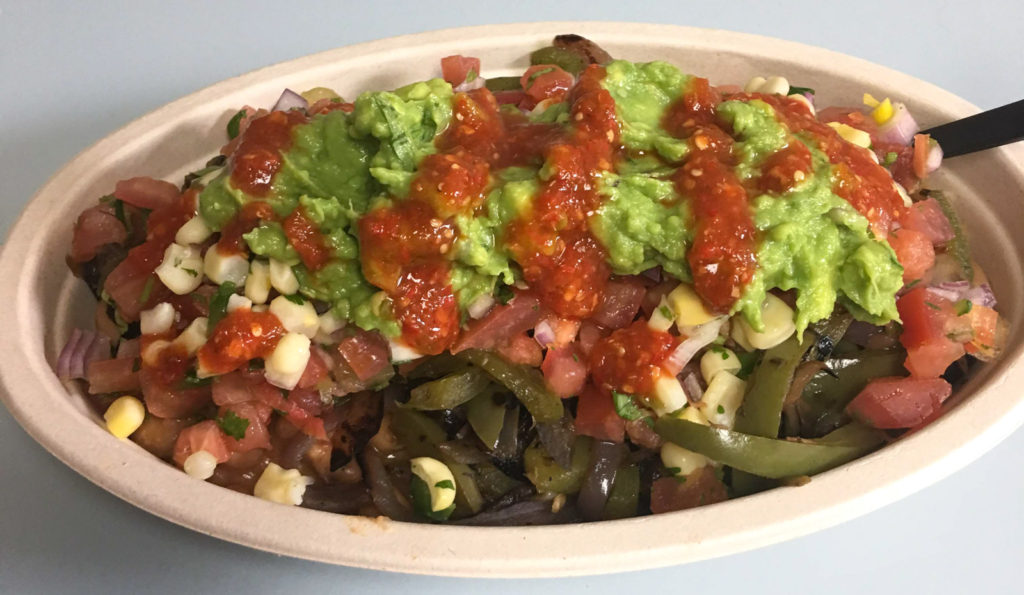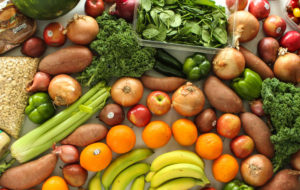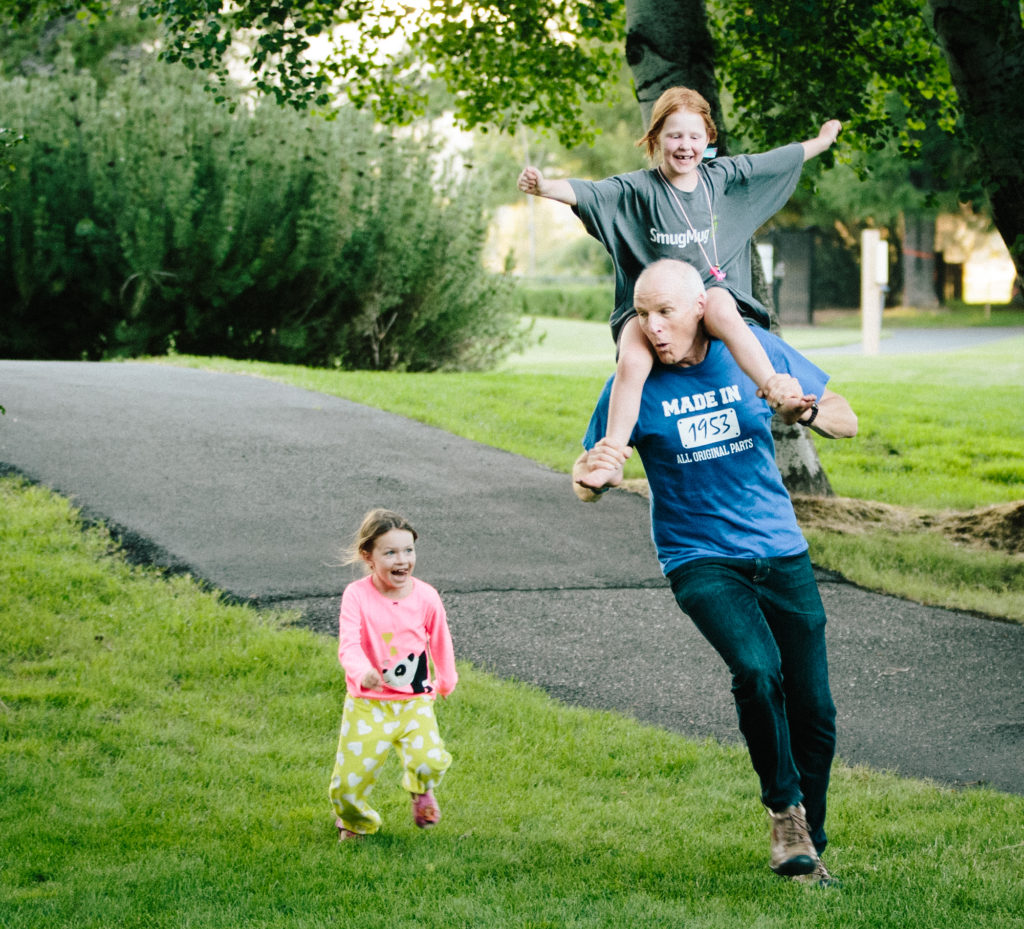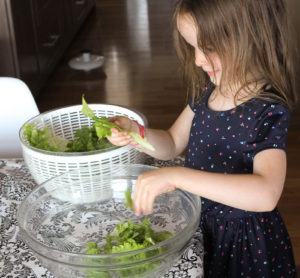Take it from this mother of 5 plant-powered kids: You can absolutely help your kids (and spouse!) enjoy a more plant-based lifestyle.

You’ve done your research and you’re convinced that a vegan, or plant-based, diet is better for your family’s health. Or maybe you’ve recently watched a compelling documentary and you’re curious enough to give plant-based eating a try.
It’s intimidating though, because serving up three meals a day to a hungry family is no joke. You might have kids who turn their noses up at new foods. You may have a meat-loving spouse, and perhaps you yourself don’t even like vegetables
I've Been There.
When I switched to a plant-based diet over a decade ago, I only like baby carrots and corn on the cob. Really and truly. Salad was definitely a no-go. What’s more, my husband considered himself a “meat and potatoes” man, and I didn’t exactly have a lot of skill in the kitchen.
Finding your groove will take some time, but with persistence, you’ll get to a point where it feels far more comfortable to throw together a plant-based meal than to go back to your old stand-bys.

Of course, just getting healthy food on the table is no guarantee that your family will eat it! It’s no fun when you’ve put all the effort into making something for your family and it’s met with grumbling (or worse.)

Let me offer some hope on that front: Although my own kids have grown up eating this way, we regularly have other children come stay in our home for extended periods of time (through the Safe Families for Children program). I’ve seen these kids go from wanting Pepsi and Flaming Cheetos to asking for more snap peas for their snack in a surprisingly short time.
Preferences and attitudes often change quickly given the right environment.
A Few Small Truths:
Sweetness
Fruit is so much sweeter when you are not constantly eating food with added sugar in it!
Adaptation
Our taste buds are constantly changing, and with time everyone will find new (healthier) favorites they'll think they can't live without.
Attitude
Kids (and husbands) can learn not to grumble. With some new habits they'll try new things with more gratitude. (Find help with table etiquette here.)
Hunger = Sauce
The absence of go-to filler snacks means we have a good appetite when meal time comes around, so everything tastes better. Hunger is the best sauce.
for creating the food environment in your home."

Here’s a perfect example: Every time I’m pregnant and morning sick, the whole family’s eating gets thrown for a bit of a loop. Why? Because I’m the one usually planning meals, stocking the fridge, officiating at the kitchen table, and setting an example. When I’m curled on the couch with a bowl, even though my husband picks up the slack when he can, everyone else is eating a lot more cold cereal. I’ll bet you can relate!
Mothers know better than anyone else that life has seasons, but setting a baseline of plant-based eating means that you have a good groove to settle back into when you come out of survival mode.
 You can find loads of lists online with “quick tips” to get kids to eat more vegetables, but what I’d like to do is walk beside you as you change your family’s food culture.
You can find loads of lists online with “quick tips” to get kids to eat more vegetables, but what I’d like to do is walk beside you as you change your family’s food culture.
Food is so emotional that there’s seldom a quick fix if you want lasting change. However, what we eat has such a big impact on our health (and weight, self-confidence, mood, and behavior) that it’s a tremendous opportunity to strengthen our family now and give our kids a solid foundation for the future.
Unfortunately, the prevailing food culture in our country is toxic right now. It’s literally making people sick and fat, dramatically decreasing our quality of life. If you were to simply follow the marketing, believe the billboards, and buy what you see lining the shelves at the grocery store, then you could only expect the results that others are getting: obesity, heart disease, diabetes, and cancer. If this paragraph sounds overly dramatic, you should see the actual data.
The wonderful (and simultaneously tragic) news is that these things are optional. While we can’t change our country’s approach to eating overnight, I know that as a mom, you have tremendous power to heal your own family.
There’s a catch though. (You knew there would be!)
Change. Is. Hard.
It just is! There’s no avoiding it. And food is so wrapped up in our emotions, our traditions, our memories and relationships, that when you consider a change to what you eat you are doing something rather enormous.
But food is so powerful. Eating well gives you more energy to pursue your life’s purpose. When you eat well, you give yourself: better sleep, more stable emotions, a healthy body weight, a longer life… the list goes on. Your good health puts you in a better position to help those you love, and your example will light the way for others. Truly the two most precious things we have in this life are relationships and our health, and putting more plants in your body can improve both!
So this is going to be hard, but it’s the good kind of hard. The satisfying, proud-of-yourself, invest-in-the-future-of-those-you-love kind of hard.
And I feel like I need to tell you right now:
You can eat as much as you want of delicious whole plant foods. No counting calories or finishing before you’re full. This is what I regularly order at Chipotle:

Also? You can totally still have chocolate cupcakes. These are made of whole plants, and they are decadent and delicious:

And no, there are no black beans hidden in there, though that is a thing. We prefer those in burritos.
Know your starting point
I strongly recommend taking the time to assess what things are like currently in your family with regards to food. It’s worth writing down, even, both because you can leverage your current habits and strengths to make the transition easier on yourself, and especially because you can better see how far you’ve come if you have a clear “Before” picture in mind.
Take an inventory of what a typical day or week currently and realistically looks like in terms of food and meals.
Where are you now?
- Do you plan meals or wing it?
- What happens for breakfast on school days? On the weekends?
- How about lunches, dinners, snacks?
- Are you eating out a lot or a little? Where and why?
- How much time are you spending in the kitchen currently?
- What role do fruits and vegetables play currently? Beans? Whole grains?
- What do people in your family drink?
- What cooking skills do you have, and are you willing to learn more?
- Do you know what you typically spend on food? Do you try to stay on a tight budget or is there some flexibility?
- Do you have any members of your family that you might describe as “picky?” (p.s. I recommend choosing different words for that, but here’s help for “picky” eaters.)
- What diet-related health concerns do you currently have for yourself or family members
Here’s an example of what you might come up with:
I’ve never quite gotten meal planning to work, so we usually end up at the grocery store several times a week picking up food for dinner. Breakfast is usually something cooked on the weekends (pancakes, eggs) and cold cereal or frozen waffles during the week. The kids are supposed to pack their own lunches, but they end up with a school lunch a few times a week. We go out to eat once a week as a family, order pizza in once a week, and pick up fast food through the drive-thru sometimes when we’re running between activities. I consider myself a good cook, but I tend to make the same dishes again and again. We eat a lot of chicken and cheese, because nobody complains when I serve those. My 6 year old thinks green things are “gross” and my husband can’t live without hamburgers. The pediatrician recently expressed concern about my daughter’s weight, and I’d like to lose about 15 pounds myself.
You get the idea!
Your situation may be completely different, and that’s why I recommend pausing to really consider it before forging ahead.
What’s the Ideal Diet?
 Unfortunately, there is a lot of confusion in the popular press about what constitutes a healthy diet. So many trendy diets come and go (Atkins became paleo, which became keto! Macros! Whole 30! “Eating Clean” and countless more). Everybody loves controversy, so we click on articles that imply red meat is healthy after all, that coconut oil is the new miracle food, and that eggs aren’t as bad as we thought.
Unfortunately, there is a lot of confusion in the popular press about what constitutes a healthy diet. So many trendy diets come and go (Atkins became paleo, which became keto! Macros! Whole 30! “Eating Clean” and countless more). Everybody loves controversy, so we click on articles that imply red meat is healthy after all, that coconut oil is the new miracle food, and that eggs aren’t as bad as we thought.
Money is the culprit. “New” diets sell books, “new” studies that seemingly contradict established truths garner clicks. If everyone just went ahead and ate vegetables there would be a lot less drama and disease in the world.
When you go to the science though, there’s very little controversy about the foundations of a healthy diet. The longest lived populations on earth eat mostly whole plants. Foods with fiber win! It’s surprisingly straightforward. The same foods prevent heart disease and type 2 diabetes as prevent obesity and dramatically reduce your risk of cancer. The more plants (vegetables, fruits, beans, whole grains) you eat and the less of anything else (meat, dairy, added sugar, oil, and processed grains) the better for your health.

The science is compelling, but almost more so for me are the real-life examples I see. I try to be a noticer of the long-term results of other people’s choices so I can more wisely choose for myself. I know plenty of people in their 30s who look trim and fit on a variety of diets. However, I know very, very few who look trim and fit into their 60s and 70s and are free of chronic illness. That is, outside the plant-based community. When you look at people who actually eat this way, it’s rare to see anyone overweight or with a chronic condition. And the longer they eat this way, the better they look and feel.
I’m always cautious when reading studies to keep in mind that “association does not prove causation,” meaning just because two things are often found together doesn’t mean one causes the other. However, in this case I’ve actually seen a diet change consistently cause a health change, so I feel pretty confident I know the long-term results of this effort. And I like them!
Here’s my mom at 68:

My kids love having an energetic grandpa who eats plants. My grandpa (his father) died of a heart attack when I was too young to remember him, so it’s extra significant for me that my dad’s arteries are clean and clear because of what he eats:

I wish we knew then what we know now. But, of course, knowing doesn’t actually help if we don’t change our actions to match.
How Did We Get to Where We Are?
If you are like the vast majority of people, your self-assessment revealed that your family eats quite a bit of processed food, meat and dairy. Fruits and vegetables play a minor role, and perhaps you’re not as deliberate about what you feed your family as you’d like to be.
Here are some reasons why, and they aren’t your fault:
We are constantly faced with a barrage of images and videos that imply our family will be happier if we feed them junk food!
Hamburger Helper will save our sanity. The kids will suddenly be polite enough to smile and say “Thank you” if you give them the new flavor of goldfish cracker. No one will squabble at the dinner table if Velveeta is on it.
If that sounds far fetched, look carefully at the next ad you see targeting you to buy food. I’ll bet it’s either a reward because “you deserve it” or an implication that food will somehow solve relational problems and stressors in your life. Of course we know that can’t be accurate, but the marketers continue to send those messages because it’s working! We’re buying the food with the happy kids in the commercials because we want our own kids to be happy. We want to feel like we have our act together, so we’re doing what the lady who seems to have her act together is doing.
 But here’s the thing: broccoli doesn’t have a very big marketing budget. Blueberries or lentils aren’t going to buy their way on to our instagram feed very often. When food is processed, it’s more expensive to buy and cheaper to produce, which leaves enough profit to invest in more flavor engineering and plenty of very targeted marketing.
But here’s the thing: broccoli doesn’t have a very big marketing budget. Blueberries or lentils aren’t going to buy their way on to our instagram feed very often. When food is processed, it’s more expensive to buy and cheaper to produce, which leaves enough profit to invest in more flavor engineering and plenty of very targeted marketing.
Processed Foods are Designed to be Hyper-Palatable
Even after we buy them, processed foods are tricking us into wanting more of them. Foods that occur in nature are flavorful and offer a variety of textures that we can appreciate. Foods produced in factories take everything to the extreme. They are so salty, so fatty and/or so sweet that they hijack our taste buds and leave us craving more of things that can never satisfy. That’s why it tough for a kid to appreciate a vegetable stir fry when he’s had Doritos for snack. Millions of dollars have been spent on the exact mouth feel and flavor of a Dorito chip. You’ve spent 15 minutes throwing the stir fry together. It’s tasty, full of color, and nutrition, and you want it to be well-received, but it’s an uphill battle for someone whose palate is accustomed to processed food.
And so, to keep the peace, to keep our sanity, we give our kids what they want. But we’ve created a situation that seems easier now but will assuredly be harder later.
But you’re flexible, you’re creative, and you’re powerful. You can effect change in your home.
Know Your Goal
What do you want for our family in terms of food? What do you want from yourself in terms of effort in this area? What kind of habits and attitudes and preferences do you want your kids to leave your house with? How about weight and health?
Here are some things that I could put on my goal list:
- I want my family to enjoy preparing and eating food together.
- I want to be wise in planning meals so that we don’t waste money on food we don’t eat, and I don’t spend more time in the kitchen than is necessary to achieve my other goals!
- I want us all to be in tune with hunger cues so that we can feel satisfied and not eating in response to emotions.
- I want eating whole plant foods to be the “regular” thing in our family, and deviations from this to be guilt-free.
- I believe this will lead to family members maintaining an ideal weight and the best health possible.
While those are worthwhile goals, that’s far too much to remember!
Author Michael Pollan summed up an ideal diet much more succinctly:
"Eat food. Mostly plants. Not too much."
- Michael Pollan
(He clarified that “food” meant real food, not processed with chemicals you can’t pronounce. )
His is a great statement! But, I haven’t found the “not too much” to be a necessary addition. It turns out you can eat lots of whole plants without weight gain, because they aren’t very calorically dense. It’s one of my favorite things about eating this way! No calorie counting or portion control. Here’s mine with adjustments:
"Eat real food. Mostly plants. Do it with love."
-Anne Bean

My reason for feeding my body well is because I love it, and my reason for feeding my family is well is because I love them. So, that means one of my goals as a mother and a wife is:
"Feed them real food. Mostly plants. Do it with love."
-Anne Bean
That was my goal when I changed my diet 13 years ago, and I think that’s why I’ve been able to stick with it ever since.
When we are motivated by love rather than by fear or guilt, the results will last far longer.
I started out convinced that this was the best way to treat my body, but without any skills in the kitchen, or any real fondness in my heart for vegetables. In fact, I would have sided with the six-year-old example up above in thinking them generally “gross.”
But I had a vision for what I wanted in my body and family future, and I knew it was dramatically different from where most Americans (and now people around the globe) are headed.
The CDC tells us that more than 70% of adults over age 20 are overweight or obese, and those are actually very conservative numbers because of the way BMI is calculated. With my build, I could carry an extra 30 pounds and still be considered “normal” weight. But I can tell you right now I would not feel as as good if I was carrying a toddler on my back 24/7! (Though it seems like some months that’s just what I’m doing… my toddlers always love their Mama.)

An insidious message in our culture has been to “love our body no matter the size or shape,” which then translates too often to indulging our body’s appetites. Of course love your body! It’s the only one we have, after all. But do treat it well because, it’s the only one you’ll have. If you feed it right, it will look its best.

Imagine a future when you’re sending your daughter off to college. “Normal” for her is showing love for her body by generally eating when she’s truly hungry and choosing plant-based, unprocessed food. That girl is going to be the one at the salad bar in the cafeteria, seeking out the lentil soup, stocking up on brown rice and bananas at the grocery store and calling you to share her delight that pomegranates are back in season. You’ll have set her up to avoid so many pitfalls in her future. And even if she turns to brownies to get through finals week on occasion, she will fall back on the habits of her childhood again and again. Because of your efforts now, she will have the skills to continue a healthier food culture and share it with others.
Of course we want this for our kids, but with anything, it has to start with us.
You First
Since becoming a mother, I’ve often seen myself reflected back in my children’s attitudes and behavior. This is so satisfying when I see my toddler sharing bites of her food with me or sweetly saying “tank oo” because she’s seen me do the same. It’s downright painful when I see my 9 year old respond snappily and I realize I’ve been short-tempered lately, and she’s just doing what she’s seen me do.
 My husband is a family physician and often has parents come in concerned about their children’s weight. These are great parents who are anxious for their children to have a great start in life. My husband often gently asks them about their own weight and habits with food as a starting point to the conversation, knowing that where the parent isn’t willing to go first, their children have little opportunity to follow.
My husband is a family physician and often has parents come in concerned about their children’s weight. These are great parents who are anxious for their children to have a great start in life. My husband often gently asks them about their own weight and habits with food as a starting point to the conversation, knowing that where the parent isn’t willing to go first, their children have little opportunity to follow.
Related example: I homeschool and am often asked how people can encourage their children to be readers. The first piece of advice I give them is to read themselves, and read to their children. If they think they are too busy to read or don’t enjoy it, they have little hope of igniting a desire in their children to do so.
If I really want to keep snacking on yogurt covered pretzels all afternoon and nursing a diet Coke, but I want my kids to be eating broccoli and hummus, I’m in a bit of a pickle.
I want to be clear: I’m not saying you need to change your diet before you change your family’s diet. Instead, I recommend that you bring your whole family on board with healthier eating at the same time. Nobody wants to be fixing multiple meals all the time if they can help it!
Just make sure you are actually on board yourself – willing to give it a good try. Kids can sniff out hypocrisy! Plus, they will unconsciously mirror what you are doing so your modeling is key. If this is just about “fixing” them, be prepared for some self-examination.
Parenting, right?

You Are the Boss of Your Family
And feel free to tell your kids I said so, if things get rough when the junk food starts disappearing at your house. You are the boss.
Seriously though, the person who is willing to buy and cook the food for the family is the one who directs what the family eats.
People are lazy by nature, and very few will object so much to a diet change that they will put for the effort to cook something different. That works in your favor here.
My husband has patients come into his practice and wring their hands that chicken nuggets are the only thing their child will eat. Kids with strong food preferences can definitely be concerning. (Here’s help for “picky” eaters.) But, as my husband tells the parent, keeping a very sympathetic tone (parenting is hard!), “If you don’t give them chicken nuggets, they won’t eat them. Promise.”

It really can be as simple as that! I’m saying simple here, not necessarily easy.
If your kids were whining to watch a tv show you thought was inappropriate for them, or if they wanted to stay up all night because they thought bedtime was torture, you likely wouldn’t say, “Well, you know what you like. Go ahead.” Parenting involves helping them learn how to make good decisions, and guiding those decisions (strongly!) when they are young. But when it comes to food, somehow we are afraid of setting limits.
Change is hard and there may be some whining and complaining for a time, but at the end of the day, the only way your kids are going to eat eat junk (generally speaking) is if you buy it for them!
If you start handling food and meals differently, the whole family will start eating differently. Behold the power of a deliberate mother.
Your Next Move: Go All In Or Make One Change at a Time?
Back in 2006, my husband and I decided to go 100% plant-based for six weeks as a trial. We knew the science was sound, but we wondered if we could possibly make it work. My husband worried he’d always be hungry and miss his meat. As for myself, I may have mentioned vegetables were high on my “Foods to Avoid” list. So, we agreed to give a good try and then re-evaluate.
We ate a lot of black beans at first, because we liked them and could change them up for different simple meals (bowls, burritos, soups, cheeseless nachos). We got better at it as we went, and we were surprised how quickly our tastes changed and how much better we felt. We were sleeping better, had plenty of energy, never had that post-meal comatose feeling, and we enjoyed eating until we were full. Our grocery budget went down, and the decision was easy: We didn’t want to go back to our old way of eating.
My husband had previously lost over 100 pounds (mostly through calorie restriction,) and we knew that a plant-based diet would be key in helping him maintain that. He was happy to have so much variety and flavor without having to limit portion size.

Doesn’t he look great, especially for having been a 280 lb teenager? (I’ll post his recommendations of how to help an overweight kiddo soon!)
But wait, you say, “Is that a legit eclair you’re eating on the streets of Paris? I thought this was supposed to be a lifestyle change!”
Yes, yes it is. But also notice in the picture the tub of hummus we picked up to take home to dunk our veggies in for lunch. We decided all those years ago to shoot for 90% plant-based, to allow for occasional dairy-based desserts, flavorful cheeses, or other favorites we didn’t want to write off entirely. We’ve stuck with this for more than a decade because it was flexible enough so we don’t feel ever deprived, but also it was a significant enough deviation from our old pattern of eating that we’ve found new favorites, that we enjoy 90% of the benefits of a plant-based diet, and we’ve truly changed the food culture in our home.
For us, going all-in on changing our diet (but only settling in at 90%) was a good choice. It forced us out of our comfort zone and we learned to swim much more quickly by jumping in the deep end.
Benefits to Going All-In
See the benefits very quickly
If you are someone who is curious if this diet will improve your health and/or weight (spoiler alert: it almost certainly will), if you go all-in, you’ll be able to see and feel the benefits within days and certainly weeks. If you just stick your toe in the water by adding a few meatless meals every week, your health is unlikely to change enough (or quickly enough) to reinforce the eating changes.
There is power in a “bright line”
Some people do much better with a clear boundary, and if you set a timeline and agree in advance to just eat plants for that amount of time, you free yourself from the wrestle of indecision and self-control for every meal and snack.
You’ll learn more quickly
It’s plants or nothing with this approach, so you’ll figure out much more quickly which plants you already like, and you’ll be more apt to try new ones. Some people describe it as learning how to grocery shop and cook all over again, but you can at least shorten the learning time!
This can be a family adventure
It might be easier to get buy-in from a spouse or teenagers if you pitch it as a trial period, or a challenge. “From now on” is scary. “Let’s try something cool for six weeks” is intriguing.
Challenges of Going All-IN
There is a potential for “easy come, easy go.”
If you have experienced boom and bust cycles with behavior in the past (and who among us hasn’t?) you know that starting something too hastily without really buying into it can lead to abandoning it just as quickly.
Creating lasting but more moderate change in your family is going to have a more positive impact on long-term health than a very short-term turnaround.
It requires more of you
If your diet is pretty standard for an affluent country, you’ll be making a lot of changes all at once to go fully plant-based. Our lives have seasons, and to set yourself up for success, make sure you have the extra “umph” to make the change before you jump all in.
(Remember how before potty training, you have to take a deep breath and gather your strength before embarking on a potty training adventure? You’ll want to pick a time when you can commit the extra effort to focus on this. I promise it’s more fun than underwear accidents though. )
You’ll also need a clear vision of where you’re headed to help you stick with it for the whole trial. Then really be aware and recognize the improvement in how you feel in order to sustain the change going onward.
The Other Option: Pick One Place to Start, and Keep going
Look at your family’s current eating, and pick one place to target. Soda? Candy? Fast food? Pop-Tarts for breakfast? Identify one area and get to work. (Here’s why I think you should eat oatmeal for breakfast if at all possible.) Remember that any step in the right direction counts for something, and it can build momentum to keep going.
Just make sure that you do keep going, because one meatless dinner a week is not going to give you the vibrant health you’re looking for. If you put in 10% of the effort, you’ll get 10% of the results. Remember that your diet will need to be significantly different from most Americans if you want to have significantly improved health.
Benefits to Slow and Steady Changes
You may get less pushback from family members
If all the favorite foods don’t disappear at once, the change may feel less threatening. You might be able to wrap new foods into your routine without raising too many red flags and quietly not re-buy others when you run out.
This benefit younger kids and spouses who aren’t food-focused. I would guess most older kids will figure it out pretty quickly, and you’ll need to either get them on board or be willing to carry on with some resistance!
You’ll be able to target and replace individual habits
Habit change tends to be more sustainable when addressed at the micro level. Switching from chicken soup to lentil soup for dinner is wonderful, but if you’ve also got a mid-morning cookie snack, a weekly donut run, and after school fast food tradition to tackle, then it may that if you go with an all-in challenge, you’d slide back into your same habits once the shine wears off.
If instead, you start by tackling the cookie snack and replace it with fruit, then come up with a new after-school tradition, etc. you might shift your baseline slowly but surely, with less friction.
Challenges of Slow and Steady Changes
You may actually get more pushback from family members
It could be, depending on the personalities and dynamic in your family that each individual change is resisted, so you are fighting lots of extra battles by making changes over time.
Tastebuds won’t change as much with small changes in diet
Broccoli just won’t taste very good until graham crackers are off the menu. Consistently feeding kids easy-to-like processed food cripples them when it comes to embracing vegetables. (And it does the same to us adults!) Added sugar throughout the day makes kale taste bitter. If it tastes bad, nobody will want to eat it for long, no matter how healthy it is.
People are constantly marveling that my kids will voluntarily chow down on green beans, a heart of romaine, or a bowlful of frozen veggies. But there would be little chance of them doing that if there were ritz crackers and fruit-by-the-foot in the pantry.

If you’re trying to simply add the good stuff without getting rid of the bad, it’ll be tricky with kids. (For adults, filling your plate with good stuff often can crowd out the bad more naturally, but kids resist the flavor of vegetables far more in my experience.)
Strike while the iron is hot?
If you’re fired up and interested in a plant-based diet, taking baby steps to get there may just take the wind out of your sails. Consider forging ahead and getting your feet wet. Ride the momentum of your initial motivation.
Take Heart
 Go ahead and consider the approaches and decide which one is the best fit for your personality and circumstance.
Go ahead and consider the approaches and decide which one is the best fit for your personality and circumstance.
However you begin, though, take heart. You don’t have to be perfect at this to help your family improve their health. It gets easier with practice, and it’s becoming popular enough that there is a lot of support from those who have walked this road before. Stick with it and you’ll see a healthier baseline emerge for you and your family.
If you decide to just start with one small step, here are 10 Steps Towards a Plant-Based Diet.
If you decide to go for it, then the next step on your journey is my Vegan FAQ, followed by my ultimate guide to once-a-month meal planning. I’ll make it as painless as possible, promise.

Hi, would you be able to share the recipes for your go to’s? I read your meal planning blog and I’m so intrigued
That was a long read but one of the best things I’ve read in a long time. Watching you and your husband make this change and seeing the dramatic results is awe-inspiring.
The thing that gets me is your kids actually like whole plant foods and aren’t demanding Pop Tarts. Amazing.